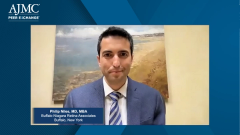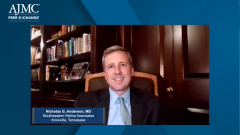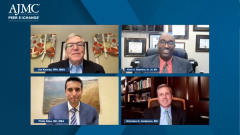
Anti-VEGF Therapy Options for Wet AMD and DME
Nicholas G. Anderson, MD; Philip Niles, MD, MBA; and Kevin U. Stephens, Sr., JD, MD, provide insight on the anti-VEGF treatment landscape and options for patients with wet AMD and DME.
Episodes in this series

Jim Kenney, RPh, MBA: Can you briefly provide an overview of the anti-VEGF treatment landscape for patients with wet AMD [age-related macular degeneration] and DME [diabetic macular edema]?
Nicholas G. Anderson, MD: Sure. As Dr. Stephens mentioned, VEGF stands for vascular endothelial growth factor. VEGF is a protein that is overexpressed in patients with macular degeneration and patients with diabetic macular edema. So anti-VEGF medications are molecules that bind VEGF and inhibit its over activity. These medications are the mainstay of therapy. It’s hard for me to overemphasize the truly revolutionary impact that these medications have had on patients with these diseases. I’ve been practicing long enough to remember treating patients with these diseases long before we had these medications. Primarily we would treat patients during those times with laser. Laser was certainly demonstrated to be more effective than doing nothing. But in essence, we would tell patients that we could probably delay the onset of blindness or perhaps keep them from going as blind as they otherwise would, but more than likely they would still have a severe visual disability. Now, it’s truly amazing to me that I can tell patients that with treatment, we should be able to allow them to maintain a functional level of vision. I honestly believe that these treatments are one of the greatest advances in all of medicine over the last several decades.
We do have a number of anti-VEGF medications available to us today. Before reviewing each medication, I will say that I frequently use every one of these medications, and I firmly believe there’s a place for each of them in our armamentarium. So we’ll look at each of the medications available to us as physicians. The first medication that was FDA approved is ranibizumab. This is marketed under the trade name Lucentis; it’s manufactured by Genentech [San Francisco, CA]. This was one of the first anti-VEGF medications that was produced. It gained FDA approval in 2006 for wet macular degeneration, and in 2012 at a lower dose for diabetic macular edema. It also has an indication for diabetic retinopathy in general.
Aflibercept is one of the other most commonly used medications. It’s under the trade name Eylea [aflibercept], manufactured by Regeneron [Tarrytown, NY]. This medication gained FDA approval in 2011 for macular degeneration, and in 2014 for diabetic macular edema. What was really important about Eylea [aflibercept] is that its initial approval was for 3 monthly loading doses. So in other words, we would treat the patient monthly for 3 doses, but then it was followed by treatment every other month. So, whereas the Lucentis [ranibizumab] original indication was for monthly therapy, Eylea [aflibercept] gained an approval for every other month therapy. It’s really important because that can decrease the treatment burden on patients. Eylea [aflibercept] can also be used more frequently than every 2 months for patients who require more intensive therapy. For diabetic macular edema, somewhat similar, there are a few extra loading doses on the front end, but then FDA approval for a Q [every] 2-month treatment. Now it’s approved for more frequent treatment and also less frequent treatment. That was really the important differentiator initially with Eylea [aflibercept] that it allowed for a longer treatment interval.
Bevacizumab is marketed under the trade name Avastin [bevacizumab]. Similar to Lucentis [ranibizumab], this is manufactured by Genentech. The FDA approves bevacizumab for systemic therapy for multiple systemic cancers. This is a key differentiator here, that even though Avastin [bevacizumab] is very widely used by all of us as retina surgeons, it is actually not FDA approved for use in the eye or designed for use in the eye. It is actually not the same molecule as ranibizumab, it is a different molecule, but there are certainly similarities. It was first described for use in the eye by Philip Rosenfeld, MD, PhD, out of Bascom Palmer [Eye Institute, Miami, FL] in 2005. Again, an important differentiator is that since it’s not manufactured or distributed in packaging appropriate for ocular use, it does require a compound pharmacy. So when we use Avastin [bevacizumab], we purchase it from a compound pharmacy, the compound pharmacy purchases a larger vial of Avastin [bevacizumab], and then we aliquot it into individual-use syringes for physician use.
Then finally we have a newer medication, brolucizumab, it’s marketed under the trade name, Beovu by Novartis [Basel, Switzerland]. This gained FDA approval in 2019 for wet macular degeneration. Another key differentiator here is that the FDA approval was for 3 monthly loading doses, but here the follow-up treatment interval was greatly extended to every 3- to 4-month treatment. That was quite a change compared to what we had been used to. This longer treatment interval obviously has a significant benefit for the patient in terms of less treatment burden. However, after FDA approval, some safety questions have a arisen with brolucizumab due to retinal vasculitis and retinal vascular occlusion, which has been found in the post-marketing surveillance. That certainly has impacted its more widespread utilization.
Jim Kenney, RPh, MBA: Thank you for that detailed summary. Any comments from Dr. Stephens or Dr. Niles to add onto that?
Kevin U. Stephens, Sr., JD, MD: He did a very good job.
Philip Niles, MD, MBA: I think that was a great summary, he well described the 4 available agents that we have. If I were to add a bit more to any one of them, it would be that people were very excited for brolucizumab or Beovu to come out recently, in 2019. We really thought that this would be a more potent medication. We hadn’t had a new medication come out really since Eylea [aflibercept] in 2011. Despite all that excitement and despite clinical trials that looked promising, once the medication came out, it was pretty quickly learned that there was a very relevant safety component to it. A lot of practices, such as my own, stopped using the medication.
We found that about 1 in 200 to 1 in 400 patients had pretty significant vasculitis or inflammation in their blood vessels that was similar to having a stroke in the eye. This medicine that we were very excited for, the usage of it came way down shortly after its release. It’s left at least physicians like myself a little bit gun shy about things that are coming out down the road. We had clinical trials and FDA approval, and then it turned out not be as good once we were able to use it on a large number of patients. Our clinical trials probably have about 1000 patients in them give or take, or around that order of magnitude, yet our diseases are so common that we’re giving them to hundreds of thousands of people. So we’re really recognizing that even if something has a very low likelihood of causing an adverse event, when given to that number of people, you’re going to see these things pop up. And as physicians who have 4 different treatment options, I think in general, the community is averse to taking risk on newer medications now. Maybe that’s more a personal view on it, but it’s definitely a concern going forward.
I think there are other things also to tack on. We do this survey every year among retina specialists, by the American Society of Retina Specialists, called the PAT [preferences and trends] survey, where we poll doctors and see what are they actually doing in practice. About 70% of retina specialists in the 2018 survey said that they use Avastin [bevacizumab] in the first line, but about 78% of retina specialists said that they would prefer to use Eylea [aflibercept] if all medications cost the same. So there are a lot of different components to why we choose a certain medicine, an element of cost-effectiveness, an element of potency, efficacy, frequency of dosing. It’s become this art of which medicine fits which patient profile and interactions with the health system in general.
Jim Kenney, RPh, MBA: I’m curious from UnitedHealthcare’s perspective, the dosing interval, the cost differences, obviously if Avastin [bevacizumab] is compounded, it’s much less expensive than the brands that are directly indicated. Is that something that is considered during the formulary process, Dr. Stevens?
Kevin U. Stephens, Sr., JD, MD: Of course. We have a whole pharmacy and therapeutic committee, and we get experts from all over the country to sit down and think about what protocol and what prior authorization process we should implement. We do some of it by co-payments, and we do some by tiering. At each tier you can have a different co-payment and different patient responsibility. But again, it’s very tough because we are dealing with vision, which is a very critical component for most of us. It could be a significant disability. It’s still a tough area, a tough space.
Jim Kenney, RPh, MBA: Absolutely.
Transcript Edited for Clarity
Newsletter
Stay ahead of policy, cost, and value—subscribe to AJMC for expert insights at the intersection of clinical care and health economics.




























































